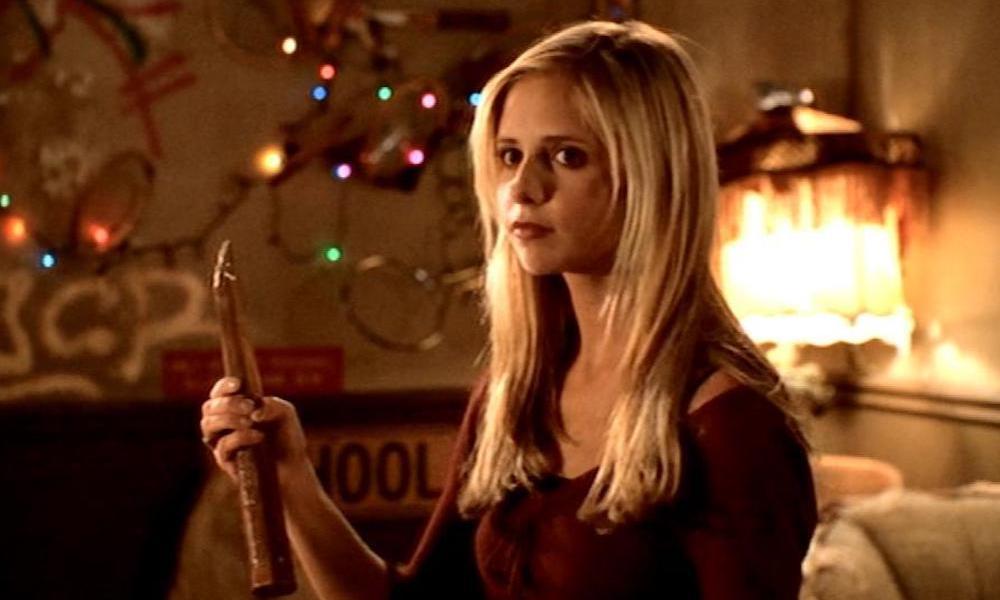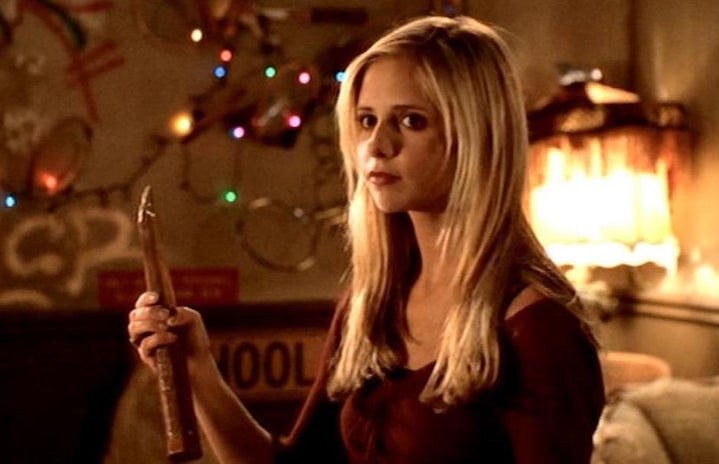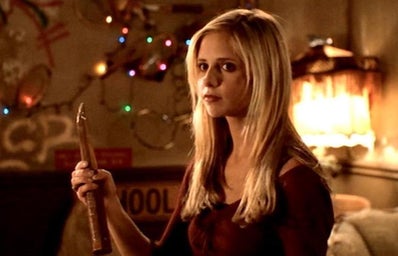Okay, I’ll admit it. I love Buffy The Vampire Slayer, but I’m only 24: This show ended before I started kindergarten, so I didn’t grow up while the show was being aired live. I had seen a few reruns on TV growing up, but I didn’t watch the show in its entirety until quarantine. From the moment I heard the opening lines of “in every generation,” I knew I was hooked. After binge-watching the show, I find myself realizing how much of a huge impact this show had on pop culture. And even though I don’t have the same experiences of people watching it week by week in the 90s, I still cannot stop thinking about this amazing show.

Buffy is not your busty scream queen
Slasher films dominated the horror world during the 70s and 80s. Jamie Lee Curtis, Sandra Peabody and Leanna Quigly were just a few of the women belting their high-pitched shrieks in movies. Even in the 1996 film Scream, the horror-obsessed characters mention how iconic the role of a scream queen is in the genre. It is, simply put, a woman who is often seen screaming at the top of her lungs in a low-cut shirt. So by the time Buffy started airing in ‘97, it’s easy to say that we’d had enough of the genre. I mean, literally, for decades, this was the example of women in horror: You had to be ready to release a high-pitched squeal if you wanted any screen (scream?) time. Instead, Buffy presents herself in the very first episode as something else. She isn’t the girl who screams and waits for a man to save her. It is her destiny, actually, to do the saving. Buffy’s character is an example of a different and subversive take on how women are presented in this genre of show.
It popularized the TV musical genre
Now it really seems like every TV show has a musical episode. While these episodes are usually not canon (meaning they are not considered legitimate in the TV’s universe), the Buffy musical episode is not only canon, but it actually serves as a huge climax between several running side plots in the show. While other shows were chalking their musicals up to a weird dream, character fantasies, or a hallucination, Buffy’s musical special had characters build onto the season’s plot while foreshadowing events later on. Though Buffy wasn’t the first show to have a musical special: Ally McBeal and Xena: Warrior Princess both did it first but with considerably less of a public response (although Xena’s episode did get a few Emmy nominations). Buffy’s episode, so wonderfully titled “Once More, With Feeling,” felt different because it paid homage to Broadway classics. It had incredible songs, all sung by the actual cast, but actually propelled the story forward instead of just having people singing for no real reason. The show was self-aware: With characters wondering what’s making everyone in the town break out into song all of a sudden. With all-original songs and choreography by celebrity choreographer and musical theatre expert Adam Shankman, this is by far my most ever watched TV episode.
Possibly the best “enemies to lovers” we’ve ever seen
For every good example of the “enemies to lovers” trope, I can think of about a dozen awful ones. And sorry to say this, but you can’t just have characters who are vaguely mean to each other but then start making out and call it enemies to lovers. The relationship between vampire Spike and vampire-slayer Buffy is one that could’ve easily been corny and predictable, but it was anything but. From season one to season seven, we see these two characters go through a huge amount of growth. This is probably what separates other enemies to lovers trope portrayals: These two characters spend years together and evolve from bitter enemies sworn by destiny to kill each other, to allies fighting a common evil, to finally actually admitting that they care about each other. It is years in the making, and the change happens slowly but undeniably once the ball is rolling. You can’t help but notice how fate really throws these characters together. Though their relationship is doomed for reasons that soon become obvious (and they have all-too-many toxic moments in between the good ones), this relationship is the ultimate enemies to lovers done right.
The women are all so different
No two women in the show are the same. There are similarities between all the vampire slayers: But the audience soon realizes that just because two women have the same destiny doesn’t mean they’ll have the same motivations. Faith and Buffy are two characters who are both supernaturally gifted in the art of slaying creatures, but pride, selfishness, flaws and greed corrupt Faith as she gains more power. Buffy is also not the goody-two-shoes that others interpret her as: She becomes morally grey as time goes on and struggles to deal with the horrific guilt of her actions. Even between Willow and Tara, a gay couple who are both powerful witches, the allure of magic can come at a horrible price. The price of which both women struggle in totally different ways. Buffy’s sister, Dawn, pushes Buffy to be someone she never anticipated becoming. Even among the more-antagonistic female characters, like Drusilla and Glory, no two women have the same motivations for their evil schemes. Each woman in the show is complete with a separate set of ambitions, powers, emotions and secrets, making them compelling across all seven seasons.
One of TV’s first lesbian kisses…among other things
The first on-screen TV kiss is credited to Law and Order in 1991, though I don’t know if I would really count it since it was very clearly done as a publicity stunt and didn’t go anywhere in the show. In 1994, the show Roseanne aired a brief lesbian kiss with a parental advisory beforehand. Soon after, the show Relativity had two lesbian characters express a genuine love for each other with a kiss in 1997. When Buffy characters Tara and Willow are shown in a relationship, it was very subtle. Audience members may not have seen the kiss coming since the characters didn’t expressively say they were in a relationship until later in the fifth season. But the kiss was groundbreaking nonetheless because it showed that two characters established seasons prior could have a healthy gay relationship and be accepted by all their peers. The couple quickly became a fan favourite, and during the musical episode, things get steamy offscreen. Buffy gave the world TV’s first lesbian sex scene (although you don’t actually see it happening, you still know exactly what’s going on), which broke tons of boundaries in 2003. In 2004. Big-time TV network Showtime took note and greenlit The L Word, a show which featured exclusively gay and bisexual women main characters. But things weren’t all good for Tara and Willow in the Buffyverse. It wasn’t long after their first intimate moment that Tara was killed in the most random way possible. A stray bullet from a character on the street hits Tara without a second chance at survival. Unlike many times in the series before, there was a zero chance she was coming back to life. Tara’s character was so important to the plot and so well-loved by fans, so why did it feel like she was being reduced to a cheap plot device? I can’t say I know for sure, but as much as I love Buffy, I can’t deny that I think this was a huge misstep on the writer’s part. The death of Tara can easily be seen as a continuation of the bury your gays trope, in which characters are established as LGBT only to be killed off as soon as things start getting good.
I loved watching Buffy over quarantine. So much so that I’ve probably annoyed all my friends by how often I keep talking about this show despite it ending in 2003. It’s a show that has undeniably shaped pop culture: From subverting certain tropes about women in horror to actually leaning heavily into the enemies to lovers trope that I can’t help but root along too. The women feel genuine and real in every part of the show, even if a certain gay character I love suffers an untimely and avoidable death.



